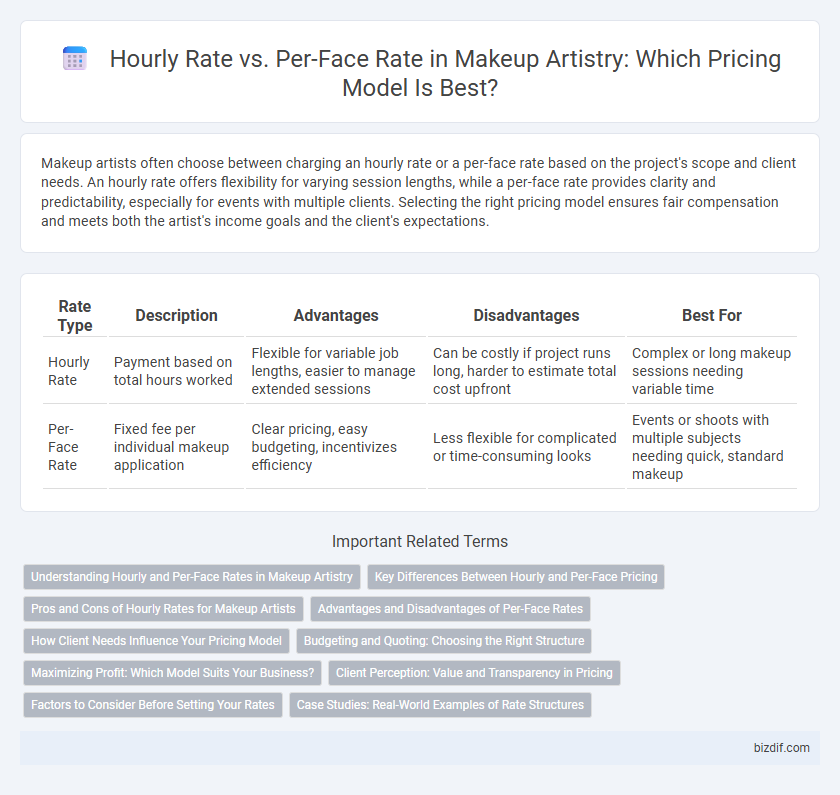Makeup artists often choose between charging an hourly rate or a per-face rate based on the project's scope and client needs. An hourly rate offers flexibility for varying session lengths, while a per-face rate provides clarity and predictability, especially for events with multiple clients. Selecting the right pricing model ensures fair compensation and meets both the artist's income goals and the client's expectations.
Table of Comparison
| Rate Type | Description | Advantages | Disadvantages | Best For |
|---|---|---|---|---|
| Hourly Rate | Payment based on total hours worked | Flexible for variable job lengths, easier to manage extended sessions | Can be costly if project runs long, harder to estimate total cost upfront | Complex or long makeup sessions needing variable time |
| Per-Face Rate | Fixed fee per individual makeup application | Clear pricing, easy budgeting, incentivizes efficiency | Less flexible for complicated or time-consuming looks | Events or shoots with multiple subjects needing quick, standard makeup |
Understanding Hourly and Per-Face Rates in Makeup Artistry
Makeup artistry pricing often involves choosing between hourly rates and per-face rates, each reflecting different project scopes and client needs. Hourly rates offer flexibility for varied session lengths and complex looks, while per-face rates provide clear cost expectations for events with multiple clients. Understanding these pricing models helps makeup artists optimize earnings and clients plan budgets effectively.
Key Differences Between Hourly and Per-Face Pricing
Hourly rates in makeup artistry charge clients based on the total time spent, allowing flexibility for complex looks or adjustments but potentially increasing costs with longer sessions. Per-face rates offer a fixed price for each individual's makeup application, providing clear budgeting and simplicity for events with multiple clients. Key differences include cost predictability, suitability for group bookings, and how variations in time affect the overall price structure.
Pros and Cons of Hourly Rates for Makeup Artists
Hourly rates for makeup artists offer flexibility in pricing, accommodating varying session lengths without the need for constant renegotiation. This method benefits clients with unpredictable or extended appointments but can lead to higher overall costs if the application process is lengthy. However, it may discourage efficiency and create uncertainty for clients accustomed to standardized per-face pricing.
Advantages and Disadvantages of Per-Face Rates
Per-face rates in makeup artistry allow clients to understand costs based on the number of individuals, enabling precise budgeting for group events or bridal parties. This pricing model can streamline booking and ensure fairness when workload varies significantly between clients, though it may undervalue time-consuming, detailed looks on some faces. However, it risks oversimplifying complex requests, potentially affecting the artist's profitability if some faces require more effort than others.
How Client Needs Influence Your Pricing Model
Client needs significantly influence your pricing model in makeup artistry, with hourly rates better suited for complex, time-intensive projects and per-face rates ideal for quick, standardized services. When clients require detailed customization or extended sessions, charging by the hour ensures fair compensation for your expertise and time. Conversely, per-face rates streamline pricing for events like weddings or photoshoots where a clear, upfront cost is preferred.
Budgeting and Quoting: Choosing the Right Structure
Choosing between an hourly rate and a per-face rate for makeup artistry significantly impacts budgeting and quoting accuracy. Hourly rates provide flexibility for varying session lengths but may lead to unpredictable costs, while per-face rates offer fixed pricing that simplifies client budgeting but can underestimate time for complex designs. Understanding client needs and project scope ensures the most effective pricing structure to balance fairness and profitability.
Maximizing Profit: Which Model Suits Your Business?
Choosing between hourly and per-face rates in makeup artistry depends on client volume and service complexity, where hourly rates benefit longer sessions with intricate looks, while per-face rates maximize earnings during high-demand events with multiple clients. Analyzing average appointment duration and makeup type enables artists to set competitive yet profitable prices, ensuring sustainability in diverse market conditions. Leveraging pricing software and tracking income per booking model provides actionable insights to tailor rates for optimal profit maximization.
Client Perception: Value and Transparency in Pricing
Clients often perceive hourly rates as less predictable, creating uncertainty about the final cost, while per-face rates offer clear, upfront pricing that enhances transparency and trust. Makeup artists who provide per-face rates can better communicate the value of their expertise, ensuring clients understand exactly what services are included. Transparent pricing models, such as flat per-face fees, foster stronger client relationships by aligning expectations and minimizing disputes over costs.
Factors to Consider Before Setting Your Rates
When setting makeup artistry rates, factors to consider include experience level, market demand, and the complexity of the service offered. Hourly rates provide flexibility for unpredictable sessions, while per-face rates simplify pricing for standard looks and group bookings. Geographic location and competition also significantly influence whether to charge by the hour or per face.
Case Studies: Real-World Examples of Rate Structures
Case studies reveal that makeup artists charging hourly rates often accommodate detailed, customized sessions, resulting in averages of $50 to $150 per hour depending on experience and location. Per-face rates streamline pricing for large events, commonly ranging from $75 to $200 per face, allowing consistent budgeting for wedding parties or commercial shoots. Analysis of real-world examples shows hybrid models combining hourly and per-face charges optimize profitability while catering to diverse client needs.
Hourly rate vs Per-face rate Infographic

 bizdif.com
bizdif.com